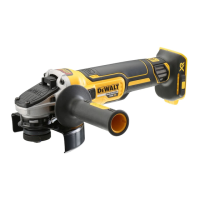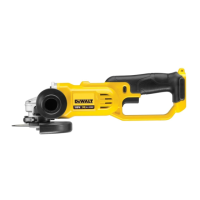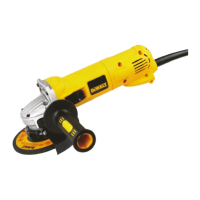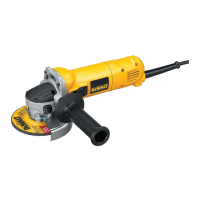14
ENGLISH
WARNING:
• Ensure all materials to be ground or cut are secured
inplace.
OPERATION
Instructions for Use
WARNING: Always observe the safety instructions and
applicableregulations.
WARNING: To reduce the risk of serious personal
injury, turn tool off and disconnect battery pack
before making any adjustments or removing/
installing attachments or accessories. An accidental
start‑up can causeinjury.
CAUTION: To reduce the risk of personal injury,
wear work gloves when handling wire brushes and
wheels. They can becomesharp.
CAUTION: To reduce the risk of damage to the tool,
wheel or brush must not touch guard when mounted
or while in use. Undetectable damage could occur to
the accessory, causing wires to fragment from accessory
wheel orcup.
Wire cup brushes or wire wheels install directly on the threaded
spindle without the use of flanges. Use only wire brushes or
wheels provided with a M14 threaded hub. These accessories
are available at extra cost from your local dealer or authorised
servicecentre.
1. Place the tool on a table, guardup.
2. Thread the wheel on the spindle byhand.
3. Depress spindle lock button
3
and use a wrench on the
hub of the wire wheel or brush to tighten thewheel.
4. To remove the wheel, reverse the aboveprocedure.
NOTICE: To reduce the risk of damage to the tool, properly
seat the wheel hub before turning the toolon.
Prior to Operation
• Install the guard and appropriate disc or wheel. Do not use
excessively worn discs orwheels.
• Be sure the inner and outer flange are mounted correctly.
Follow the instructions given in the Grinding and Cutting
AccessoryChart.
• Make sure the disc or wheel rotates in the direction of the
arrows on the accessory and
thetool.
• Do not use a damaged accessory. Before each use inspect
the accessory such as abrasive wheels for chips and cracks,
backing pad for cracks, tear or excess wear, wire brush for
loose or cracked wires. If power tool or accessory is dropped,
inspect for damage or install an undamaged accessory. After
inspecting and installing an accessory, position yourself and
bystanders away from the plane of the rotating accessory
and run the power tool at maximum no‑load speed for one
minute. Damaged accessories will normally break apart
during this testtime.
wheel breakage and wheel contact. See the Accessories
Chart for moreinformation.
1. Place the tool on a table, guardup.
2. Install the unthreaded backing flange
7
on spindle
4
with
the raised centre (pilot) facing the wheel.
3. Place wheel against the backing flange, centreing the wheel
on the raised centre (pilot) of the backingflange.
4. While depressing the spindle lock button and with the
hex depressions facing away from the wheel, thread the
clampnut
8
on spindle so that the lugs engage the two
slots in thespindle.
5. While depressing the spindle lock button, tighten the
locking flange with awrench.
6. To remove the wheel, depress the spindle lock button and
loosen the threaded locking flange with awrench.
Mounting Sanding Backing Pads (Fig.A,F)
NOTE: Use of a guard with sanding discs that use backing pads,
often called fiber resin discs, is not required. Since a guard is
not required for these accessories, the guard may or may not fit
correctly ifused.
WARNING: Failure to properly seat the flange/ clamp nut/
wheel could result in serious injury (or damage to the tool
orwheel).
WARNING: Proper guard must be reinstalled for grinding
wheel, cutting wheel, sanding flap disc, wire brush or
wire wheel applications after sanding applications
arecomplete.
1. Place or appropriately thread backing pad
18
on
thespindle.
2. Place the sanding disc
19
on the backing pad
18
.
3. While depressing spindle lock
3
, thread clamp nut
20
on
spindle, piloting the raised hub on the clamp nut into the
centre of san ding disc and backingpad.
4. Tighten the clamp nut by hand. Then depress the spindle
lock button while turning the sanding disc until the sanding
disc and clamp nut aresnug.
5. To remove the wheel, grasp and turn the backing pad and
sanding pad while depressing the spindle lockbutton.
Mounting and Removing Hubbed Wheels (Fig.G)
Hubbed wheels install directly on the M14 threaded spindle.
Thread of accessory must match thread ofspindle.
1. Remove backing flange by pulling away fromtool.
2. Thread the wheel on the spindle
4
byhand.
3. Depress the spindle lock button
3
and use a wrench to
tighten the hub of thewheel.
4. Reverse the above procedure to remove thewheel.
NOTICE: Failure to properly seat the wheel before turning
the tool on may result in damage to the tool or thewheel.
Mounting Wire Cup Brushes and WireWheels
(Fig.A)
WARNING: Failure to properly seat the flange/ clamp nut/
wheel could result in serious injury (or damage to the tool
orwheel).

